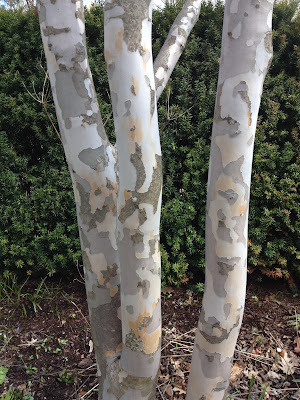As
the yew hedges have matured in the last 15 years, the scale and
proportions of the plantings have shifted. In the meantime, saplings
have become trees. As the height of the hedges rises, I have become much more
interested in the negative space that the borders in front of the hedges
have created against dark green foliage of the yew walls. I am reminded of a Dan Kiley quote that "proportion is
everything." Above is a photo of the garden last week during our first
snowfall. The yew hedge has finally created the room of my dreams and I
am trying to keep the scale and proportion of all the elements in check
for the best effect.
Here
is the same view of the Upper Garden, 'Hall with Balls' and Lower
Garden in October. I am planning to add another wall of yew along the
street (replacing the picket fence) to the far left of the photograph to
enclose the 'Hall with Balls'.
The enclosure with make the 'Hall with Balls' a stronger, more unified, space. I will continue to prune up the trunks on the Cornus officinalis
to contrast the dark yew hedge. I am also editing the placement of the
box balls to form the most pleasing visual arrangement. They have grown
more quickly than expected and have become more crowded than I had
imagined.
As I mentioned in my last post, I am transforming a pair of symmetrical stewartias into a grove of stewartias.
It is the texture of the bark and the sinew of the trunks that interest me most.


I
am beginning to lower the height of the under-planting of perennials and shrubs
beneath the stewartias in order to better display the buff-colored
trunks which contrast beautifully with the dark yew hedges. I am
enjoying the negative space that is created by the trunks from a
distance and at close examination.
The Right Border in early spring
The Right Border in the summer. I want to adjust the texture, height and color of the plantings to best feature the negative space of the backdrop of the yew hedge.
The Left Border in early spring
Plants
with dark foliage will contrast the granite wall best. The plantings
will be fine-tuned in the next couple of years to accentuate the line
between the plants and the grey wall.
I
have been also working on limbing up the crabapple tree in the Upper
Garden to have the most elegant shape possible. As the garden matures,
the way in which trees are pruned becomes an important feature in the
garden against hedges, walls and fences.











I look forward to the changes you describe, Michael--the grove of Stewartias, the new hedge along the street side of the hall with balls, the fine tuning of plantings backed by the yew hedge and the stone wall, and the attention to pruning up trees as the garden matures. I'm becoming aware of the importance of the pruning up to emphasize the beauty of trunks, even in my vastly different garden.
ReplyDeleteIt would fun for you to visit again, James, after I have made the changes. I am excited about the new yew hedge. I think it will solve the problem of the slope down the street which I haven't handled very well. I enjoy sculpting the tree trunks. I am always looking for inspiration on my hikes. I admire what you have done with dead trees in your garden!
DeleteThe garden is looking wonderful, Michael. It seems that your plans will make it look even better.
ReplyDeleteThanks, Pat, for your kind words. As I am maturing as a garden maker, I am attempting to make each section part of a coherent whole. The maturing trees and hedges seem to tell one what to do if one watches and listens.
DeleteI so agree, Michael. Listening and watching tells us a lot about what to do. Impatience is my problem... giving the quiet time to speak and being quiet enough myself to hear what I'm being told. And this isn't only in relation to gardening, I'm afraid!
DeleteI am slow and steady by nature so the patience part hasn't been difficult for me, Pat. That may change as I am getting older!
DeleteIt will be interesting to see how things progress in your garden, Michael. BTW, do you have favorite pruning tools? I'm curious what you use to clip the box balls..... I envisioned clipping some I. glabra 'Shamrock' in my front garden but they've lost some much lower foliage I think I may replace them w/ I. 'Densa' which I've read doesn't do that. I could try box but we've got the blight down here in VA and I'm not fond of the smell, either. But they do serve a purpose... I've also got some I. vomitoria 'Gremicr', a Yaupon Holly w/ very small leaves and small habit, probably not hardy where you are, that could take clipping.
ReplyDeleteMerry Christmas!
Sarah P.S. Have you seen the Mt Washington shot at the Currier Museum? I hear it's good. My sister just retired from there in June.
Hi Sarah,
DeleteBelieve it or not, I used my Felco pruners for the first few years when the boxwood were very small. A couple of years ago, a friend recommended the Little Wonder double-edged electric hedge trimmer which is great for making rounds or any shape. It has two handles that make sculpting much easier. My boxwoods are Sheriden hybrids (English box crossed with Korean box; they often have Green in the name: Green Gem, Green Mound, Green Mountain) and they have done well for me. They don't smell quite as strong as English box. I haven't had much luck with I. glabra 'Shamrock'; nice to hear about "Densa'. I might consider I. crenata here in NH if we get box blight. Thanks for the Mt Washington tip. I am a avid hiker and will try to see it before it closes.
Merry Christmas to you!